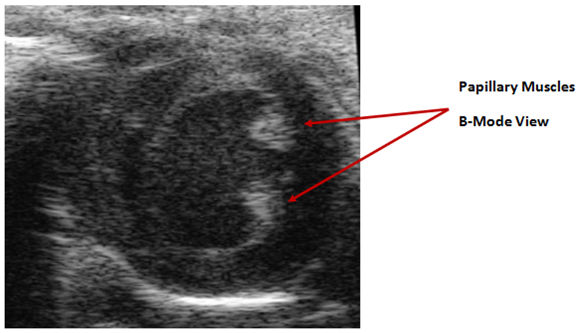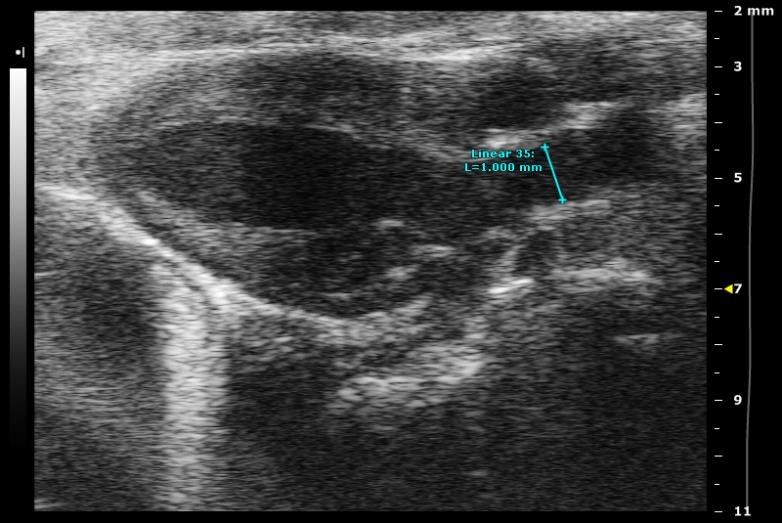Jump to:
Purpose
To assess the functionality of the heart in order to determine the presence of a mutant phenotype.
Experimental Design
Procedure
1. Place animal in induction chamber and anesthetize the mouse and ensure sedation.
2. Once the animal is sedated, move it to a nose cone for hair removal using cream. Only apply cream to the area of the chest that will be utilized for imaging. Once the hair is removed, wipe area with wet gauze to ensure all hair is removed.
3. Move the animal to the imaging platform and tape its paws to the ECG lead plates and insert rectal probe. Body temperature should be maintained at 36-37°C. During imaging, reduce anesthesia to maintain proper heart rate. If the animal shows signs of being awake, use a higher concentration of anesthetic.
* Before imaging, decrease the Sector X so that the frame rate increases to 110 and change the orientation of the heart by clicking the dot as shown in Fig. 1.
4. Apply gel on to the area to be imaged.
5. Lower the probe to the gel until it makes contact, making sure that all areas of the probe are covered with gel.
6. The image of the heart should be taken in the short-axis mode with papillary muscles being the point of reference. The papillary muscles should be parallel to the screen as shown on Fig. 2. Some manipulation of the platform may be necessary in order to get a clear image.
7. Once the papillary muscles are parallel in B-Mode, press the M-mode button and place the yellow line in the middle of the LV. Change the Display window to 1000ms. If image is not clear as in Fig. 3, move the yellow line to the left or right. Another option is to leave the line in the center of the LV and move the platform left or right, forward or backwards.
8. When a good clear image is obtained press the Cine store button to save the M-mode data. Save at least 4 short loops of data.
9. To view the heart two dimensionally in the parasternal long-axis choose the Presets: B-mode, parasternal long axis view.
10. Place the transducer vertically to the animal body on the left side of its sternum with the notch of transducer pointing to the animal head. Optimal parasternal views are obtained by adjusting gain settings for visualization of endocardial and epicardial walls (approximately 45 dB). A proper image in this orientation includes the left atrium and ventricle, a slight portion of the right ventricular wall and the output of the aorta, with the heart forming a gourd-like structure. The beginning ascending aorta and the apex of the heart are on the same horizontal line.
11. When a good clear image is obtained press the Cine store button to save data. Each animal should have at least 3 short B-Mode, parasternal long axis view images captured.
12. Once imaging is complete, remove animal from the platform and allow to recover atop a heating pad.
Figure 1.
Figure 2.
Figure 3.
Offline analysis:
To define the diameter of the aortic arch, ensure that this measurement is done during systole of the heart. The diameter is to be measured perpendicular to the aortic wall (Figure 4). Use the ruler to measure the diameter. Place it on the right of aortic valves and on the left of the beginning right atrium. Each animal should have at least three ascending aorta diameters taken.
Figure 4.
Notes
Each animal should have at least four short M-Mode images captured.
In order to analyze these data files, you must use the software package provided by the manufacturer. Perform the analysis using the best image by tracing a minimum of four cycles as well as averaging two wall measurements for diastole and systole as seen in Fig. 3. The parameters derived from the trace are End systolic/diastolic diameter (d;s/d;d), systolic/diastolic volume (V;s/V;d),stroke volume (SV), ejection fraction (EF), fractional shortening (FS), heart rate (HR) and body temp (temp).
All four images can be uploaded as part of the data submission.
These data points can be displayed in a bar graph or a line graph.




